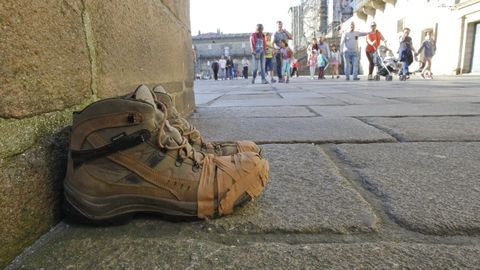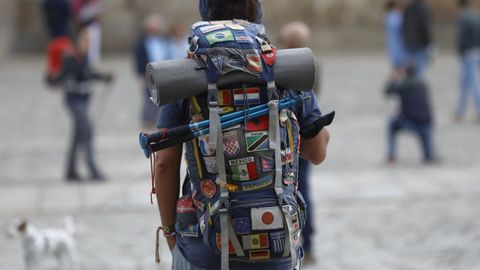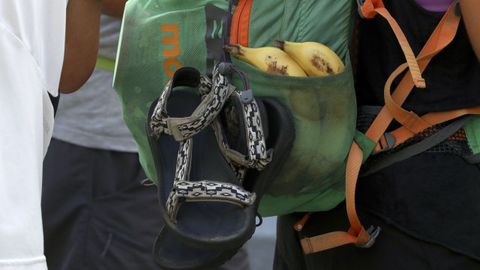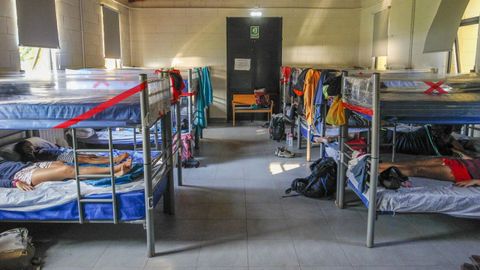The pilgrim's kit: what to take with you on the Camino de Santiago (Way of Saint James)
VEN A GALICIA

With spring upon us, here are some tips from the experts on clothing, backpacking and how best to prepare
13 may 2022 . Actualizado a las 05:00 h.Are you planning to do the Camino de Santiago this spring? Now that the restrictions have been lifted and with the Easter holiday season and the Jacobean Holy Year upon us, pilgrims will be flocking to Galicia and to each and every one of the Jacobean routes running through the region. With the cathedral in their sights, rucksack on their backs and boots on their feet, those who set off in search of yellow scallop shells should make sure they’re suitably prepared. But what should they bring? A few local experts give their advice on clothing, how to pack and other preparations. Read on to learn about the pilgrim’s kit.
Footwear: the bread and butter
«It’s essential to choose the right footwear,» says Dani Keral, who, aside from being a travel blogger and experienced pilgrim, works as a physiotherapist in Santiago de Compostela. «Even though we’re now in spring, it needs to be waterproof because Easter in Galicia means rain,» he adds. Your best bet is hiking footwear, whether you opt for boots, trainers or sandals. And don’t even think about wearing new shoes on the Camino.
At Pilgrim, a travel agency specialising in the Camino de Santiago, they recommend trekking shoes for spring, as they weigh less and are able to keep out the rain typical at this time of year. However, if the weather forecast is looking more like autumn, you can certainly opt for boots instead. Dani Keral explains that if you go for boots, best to make sure they’re medium or low-cut as otherwise things can get too hot. As for the technical characteristics, the Gronze online guide for pilgrims explains that your choice of footwear should be “light and resistant, not too rigid, and made of breathable fabric”, but above all comfortable.

Another aspect you need to think about if you want to look after your feet and avoid the dreaded blisters is socks. «The best thing you can do is to wear hiking socks and make sure they’re the right size,» explains Dani Keral. Pilgrim add that they should be seamless and «be sure to bring some flip-flops with you. They’re light, won’t take up much space and are great for giving your feet a welcome break from your boots.» If you want to get some sightseeing in at the end of the stage, you can also throw in some light shoes, which will also come in very handy if your regular shoes get wet. And a nice trick for drying out your boots is to fill them with crumpled newspaper, explains Gronze.
Clothing: something fit for spring
As with footwear, your clothing should fit «the season in which you plan to do the Camino,» Pilgrim points out. However, there are a number of essential items you should always have on you, they add. «The most comfortable choice would be hiking attire,» explains Dani Keral. In any case, the best way to keep warm and cool is to dress in layers. Your best bet for this time of year would be a breathable T-shirt, a zip-up sweatshirt with or without a fleece lining and then a waterproof layer.

For cold days, you can wear a thermal T-shirt and then have a synthetic insulated jacket on top, «which will keep you warm while you walk,» explains the physiotherapist. At Pilgrim they would also opt for a light coat: «Bear in mind that you won’t be dealing with extreme temperatures and you’ll be wearing it also at the hottest part of the day.» As it will be springtime, you won’t be needing a windbreaker on more inland routes, unless perhaps you’re heading through coastal areas. Whether or not you wear it will depend on how cold you are feeling and on the vagaries of the weather, which this Easter time doesn’t seem to be following typical seasonal patterns.
What is essential at any time of the year is a waterproof layer «both for your body and your backpack,» remarks Dani. «Bring a long-sleeved poncho to protect you from the rain, as this is an absolute must. You can put it on quickly, it’ll cover your rucksack and it’s also nice and light,» explain Pilgrim. An alternative to the poncho, which has the disadvantage of not covering your lower legs, «is to bring a waterproof jacket and trousers, and a waterproof backpack protector,» claim Gronze.
For the waist-down, Dani Keral recommends a pair of detachable hiking trousers to suit the temperature. Leggings are also a good choice and can be switched out for shorts if the weather gets too hot.

It is also essential to wear a cap, hat or head scarf, as well as sunscreen. «Remember that you’re going to be exposed to the sun for 6?7 hours a day,» warns the physiotherapist. Pilgrim add that a pair of sunglasses is essential. A cap, hat and gloves may or may not be necessary, though the experts always advise checking the weather forecast before heading out. Failing that, they can be bought in any of the towns to be found along the route.
The rucksack: don’t even think about packing those just-in-case items
Even more important than your choice of clothing is your choice of backpack. Dani Keral knows all about this and the back problems that can be caused by carrying too much or wearing your rucksack the wrong way. «It’s best to attach it to the pelvic area so that your shoulders aren’t carrying all the weight,» he explains. As for the size, all three experts are clear on one thing: it should not be too big. They recommend anything from 35 to 40 litres, with 50 litres being the absolute limit.
Aside from the size of the backpack, another key factor is the weight. «Even if you’re going to be there for a week, you need to pack it as if you were going for three days and then be sure to get your laundry done,» Dani explains. Most hostels now have washing machines and even dryers. When booking your accommodation, this is definitely something to bear in mind. Even if your lodging doesn’t offer a laundry service, you can find a laundrette in almost any town.
The weight of the rucksack should not exceed 10% of your body weight, explain Gronze. However, this can be a problem for people who weigh relatively little. If you weigh 50 kilos, does that mean you can only carry a load of five kilos? «You don’t have to follow it strictly, it’s meant as a rough guide,» explains Dani Keral. Although you can exceed the limit a bit if you have no other choice, he recommends sticking to the basic rule; and «Don’t even think about packing those just-in-case items,» he adds.

So, what stuff to take? «The things you should be taking with you in your rucksack for the Camino de Santiago depend mainly on one factor: the time of year,» explain Pilgrim. «Aside from what you will be wearing, you can choose to bring an extra pair of trousers, a waterproof poncho or a mackintosh that you can put on when it rains, two to three sports shirts, a sweater, changes of underwear and seamless socks.»
In addition to your clothes, there should be room for a towel (preferably microfiber) and some flip-flops, which you will need when showering in hostels. Your toiletries should always include a good sunscreen. And if carrying your luggage is going to be a problem, you can always arrange a rucksack transport service, such as the one provided by Correos. In this case, you can bring along a smaller backpack containing just the basics for each stage.
First aid kit, water and Vaseline: the bare essentials
But what are the essentials? To start with, petroleum jelly for the feet, which should be rubbed on every morning before putting on your socks to prevent blisters. «People who sweat a lot should reapply several times throughout the stage,» adds Dani.
A first-aid kit with the basics should also be on you at all times. «An anti-blister kit and painkillers,» according to Dani. If blisters do come up, you will need a hypodermic needle to pop them, an antiseptic (such as alcohol) to disinfect and, if necessary, a wide adhesive to cover the wound. «I don’t agree at all with threading the blister to drain it,» remarks the physiotherapist, who believes that if the injury prevents you from walking, it’s better to take a rest day before continuing. Band-aids, gauze and adhesive tape can also be added to your first-aid kit. If you need anything else, you can always find a pharmacy along the route.

Of course, you can’t do without water. «A canteen of one and a half or two litres is ideal because you can always refill it. Don’t take less, as you’ll need to stay well hydrated, while taking more would add too much weight,» explains Dani. It is also advisable to bring some food that won’t take up much space for a boost of energy. «And be sure to bring an extra bag for you to put your rubbish and waste in!», add Peregrino.
Accessories: Should I take a walking stick? And what about a sleeping bag?
Once you’ve packed all your essentials, you might want to add a few extras. According to Gronze, popular choices include a torch, a pocket knife or an external battery for the mobile phone.
As to whether a sleeping bag is needed, Pilgrim clarify that «many lodgings will provide sheets and blankets.» To avoid carrying a sleeping bag, all you need to do is plan where you are going to sleep each night. If you do choose to bring one — whether to provide an extra layer against the cold or because of your choice of lodging — you’re best off going for one that is «ultra-light and ultra-compact», explain Gronze.

Another common doubt facing many a pilgrim is whether to bring a walking stick. «They do help with balance and weight distribution,» say Pilgrim, but «they are not really necessary,» adds Dani Keral. «They can certainly be useful in specific cases, such as for people with knee injuries. It’s a joint that really suffers when walking downhill,» he explains.
Preparation is key
The risk of physical ailments is another factor to be taken into account before setting off. «The Camino de Santiago often reveals injuries that we didn’t even know we had,» explains the physiotherapist. Therefore, people who do not regularly exercise should make sure they get some exercise in a couple of weeks in advance so as to «find out what physical condition they are in and acclimatise their body.»
Preparation is key to preventing physical problems that might otherwise prevent you from finishing the Camino, he explains. Ideally, you should be steadily increasing the distance and including uphill sections. For elderly pilgrims, this step is essential as they may encounter more problems if they overexert themselves. Children, he claims, do not tire quickly, but nor do they know how to pace themselves. You should therefore make sure that they don’t burn through all their energy at the beginning of the stage.
Another good piece of advice from the experts is to allow for an extra day just in case you need that time to recover from an injury. While the ultimate aim is to reach Santiago, pushing yourself too hard may force you to pull out early. So while some planning is necessary, each person can then follow his or her own pace. «There are few sensations quite as pleasurable as letting the Camino itself and our own personal circumstances set the pace, rather than having things forced on you,» remark the experts at Gronze. Therefore, their advice for all pilgrims is to try to enjoy the experience. Bo Camiño, as they say!